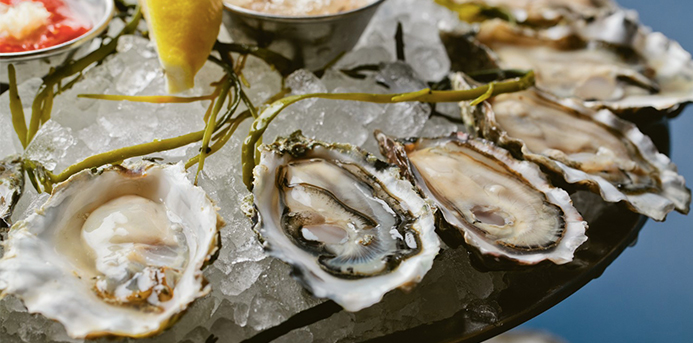Though they’re currently surging in popularity, oysters have been a part of the Chicago dining experience since before the Great Chicago Fire of 1871.
In mid-19th-century Chicago, the biggest and best-known restaurants in the city were in hotels, like the Tremont Hotel and Sherman House. The menus at these hotel-restaurants followed the French tradition: Dishes were coursed out, soup to nuts, and oysters were frequently listed as a starter. During this time, according to William Rice writing in the Chicago Tribune, there were seven oyster “depots” and four oyster saloons in Chicago, which is a surprisingly high number of oyster outlets for a city located many miles from the salt water where the oysters live.
East Coast oysters were once shipped by barge along the Erie Canal and then by rail to Chicago and points west. They were packed in sawdust, which somewhat amazingly kept the oysters (or at least most of them) fresh until they were shucked for Midwestern diners. Obviously, in warmer months, it was harder to keep oysters in good condition during that relatively long and unrefrigerated journey; that’s one reason behind the rule of thumb that you should eat oysters only during months that contain an “r” (the cooler months of September through April).
Refrigeration now allows almost anything to be shipped anywhere at any time, rendering the “r” month rule largely obsolete. Still, there’s a tendency for restaurants to follow traditions, so they ramp up their oyster offerings in the cooler months.
In Chicago, here are a few places where you can get the very best of these bivalves, both raw and cooked.
Shaw’s Crab House
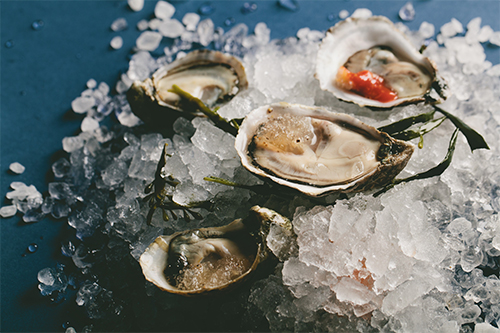
A monument to not only Chicago’s past (there’s a palpable old-timey vibe about the place), Shaw’s is also a testament to the diversity and wonderfulness of the simple oyster, served raw and, usually, unadorned. Come nightfall, both the main dining room and the more bar-like Blue Crab Lounge are packed to the gills with seafood lovers. What that means is that Shaw’s goes through a lot of oysters, and that’s a very good thing: As with all seafood, freshness is key, and you want to eat oysters at a place that regularly receives them fresh and runs through them quickly. Shaw’s, which goes through many thousands of oysters every week, usually has a rotating menu of 12 oysters, six from both coasts, expertly shucked. 21 E. Hubbard St., Chicago, 312-527-2722
Homestead on the Roof
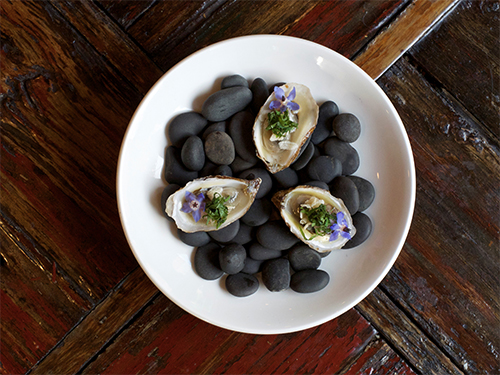
Part of the Fifty/50 Restaurant Group’s growing restaurant empire, Homestead on the Roof offers raw oysters dressed with micro-planed jalapeno and yuzu, an Asian citrus fruit that Chef Scott Shulman explains has a tartness that “breathes life into the dish.” This is one of the most beautiful oyster presentations you will find. On top of the raw oyster are Vietnamese puffed rice and a chiffonade of shiso, the pungent leaf sometimes used with sushi. There’s a lot going on with this oyster, which might raise the concern that the bivalve’s subtle oceanic tang could be lost in a confusion of condiments. Fear not: The elements in Shulman’s preparation all come together, creating many levels of flavor and dimensions of taste, working harmoniously together to foreground the fresh and delicious oyster flavor. 1924 W. Chicago Ave., Chicago, 773-332-2354
Chicago Oyster House
This “industrial-chic” space offers oysters in a variety of formats, raw and cooked with a range of toppings. You can have the oysters done up in a take on the traditional Rockefeller style, with spinach and cheese, or in Firecracker-style, with spices, some herbs and a squirt of fresh lime. The Southern Fried oysters, served with house-made hot sauce, are prepared using freshly shucked oysters, which you can also get as shooters, dressed with quail egg yolk, scallion, radish, tabasco and citrus soy. Though you can get other seafood and prime steak at Chicago Oyster House, this South Loop place is really all about the oyster. 1933 S. Indiana Ave., Chicago, 312-225-8833
Maple & Ash
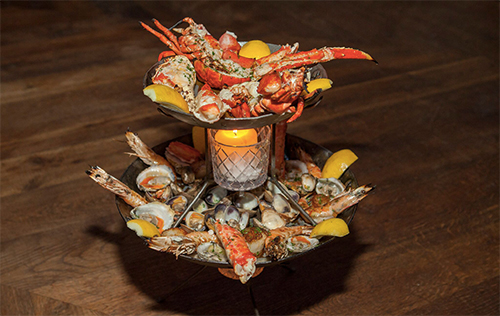
This swank and stylish restaurant features seafood and meat cooked over open flames. The oysters served at Maple & Ash can be ordered by themselves, but they’re also featured on the spectacular Fire Roasted Seafood Tower (along with scallops, Alaskan King Crab, Maine lobster, Manila clams and Gulf shrimp). The oysters are roasted on an open hearth before finishing with garlic butter and chili oil, which adds just a hint of richness and heat. “Roasting the seafood intensifies and allows for the true flavor profile to shine through,” says Executive Chef Danny Grant. Maple & Ash has a huge menu, and you’ll probably never have a steak as mind-blowingly good as their Wagyu, but before you dive into the carnivorous options, start with those spectacular oysters. 8 W. Maple St., Chicago, 312-944-8888
Proxi
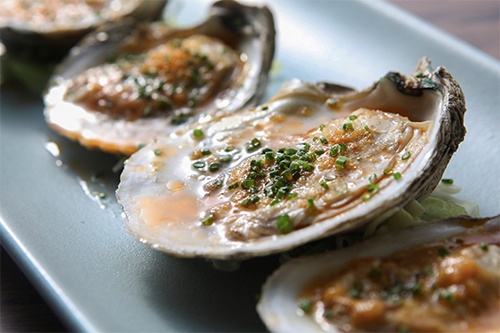
The new restaurant from Sepia owner Emmanuel Nony and Chef Andrew Zimmerman, Proxi is solidly within the American Innovative tradition (also practiced at Michelin 3-star places like Alinea and Grace), but with a decidedly global focus. There’s a veg-forward version of bhel puri, the Indian street food, a tempura elote, a mix of Japanese and Mexican standards … and coal-roasted oysters with ssamjang butter. A Korean condiment, ssamjang butter is a mix of soybean and chili paste, bumped up with garlic and mellowed with honey, a fantastic complement to the slightly briny oyster, firm and flavorful from open-fire cooking. If you’ve been avoiding cooked and dressed oysters, this dish could turn you around. 565 W. Randolph St., Chicago, 312-466-1950
Portsmith
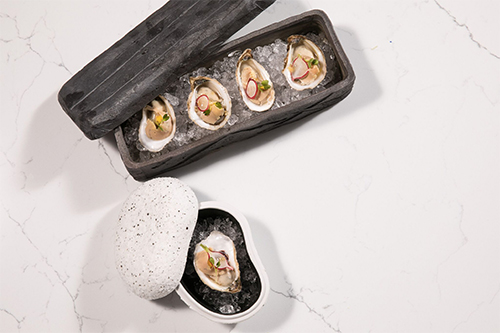
Opened in late August in the Dana Hotel, Portsmith’s name suggests the seafood-centric menu you’ll find there: “Port” conjures nautical associations, and the chef is the “smith” who works with the products of the sea. The dish called “Fancy Oysters” includes yuzu (citrus is famously friendly with oysters), green apple (again, acidity and oysters pair well) and, somewhat surprisingly, a little bit of foie gras. The fattened duck liver adds a fattiness never found in oysters, and it contributes to what is a very fine mouthful. You can order the Fancy Oysters separately, and you probably want only one or two before dinner, lest the oysters themselves become dinner (we can think of worse fates). Of course, for the more traditional, you can also have the oysters simply shucked and served with the traditional cocktail sauce and mignonette. 660 N. State St., Chicago, 312-202-6050
An Expert Pairs Beverages with Bivalves
Because cooked and dressed oysters have a highly variable flavor profile, Steve LeHaie of Shaw’s Crab House provided some guidance for selecting drinks to pair with raw oysters, which will have a more consistent taste than prepared oysters. LeHaie has decades of experience overseeing one of the very best oyster restaurants in Chicago, so he has some definite opinions about what drinks works best with oysters.
Beer
Beer, especially Guinness, is the go-to for many oyster eaters, and LeHaie tells us, “I like a Pilsner, such as Lagunitas Pils, which is not as heavy as an ale, crisp and clean, with body. Compared to Bud, which is also a Pilsner, it’s got crispness, but it’s also got flavor.”
Wine
Sauvignon Blanc, the Chardonnay of the 21st century, is always a safe bet for pairing with oysters. LeHaie, however, explains that, “My favorite is Muscadet, particularly in the summer, very good cold and crisp with good mineral quality and a dryness that goes really well with oysters.”
Cocktails
For cocktails, you want a drink that won’t obliterate the delicate flavors of the sea creature, so LeHaie recommends a “Gin martini with Bombay Sapphire, up, very cold with a twist because the citrus complements the seafood whereas an olive can change the flavor. The herbal quality of gin and its silkiness work very well with oyster.”
More from Make It Better:
- 9 Navy Pier Restaurants You Need to Try
- 13 Must-Eat Dishes at Top Chicago Restaurants
- 16 of the Best Chicago Rooftop Bars and Restaurants

David Hammond is Dining and Drinking Editor at Newcity and contributes to the Chicago Tribune and other publications. In 2004, he co-founded LTHForum.com, the 15,000 member food chat site; for several years he wrote weekly “Food Detective” columns in the Chicago Sun-Times; he writes weekly food columns for Wednesday Journal. He has written extensively about the culinary traditions of Mexico and Southeast Asia and contributed several chapters to “Street Food Around the World.”
